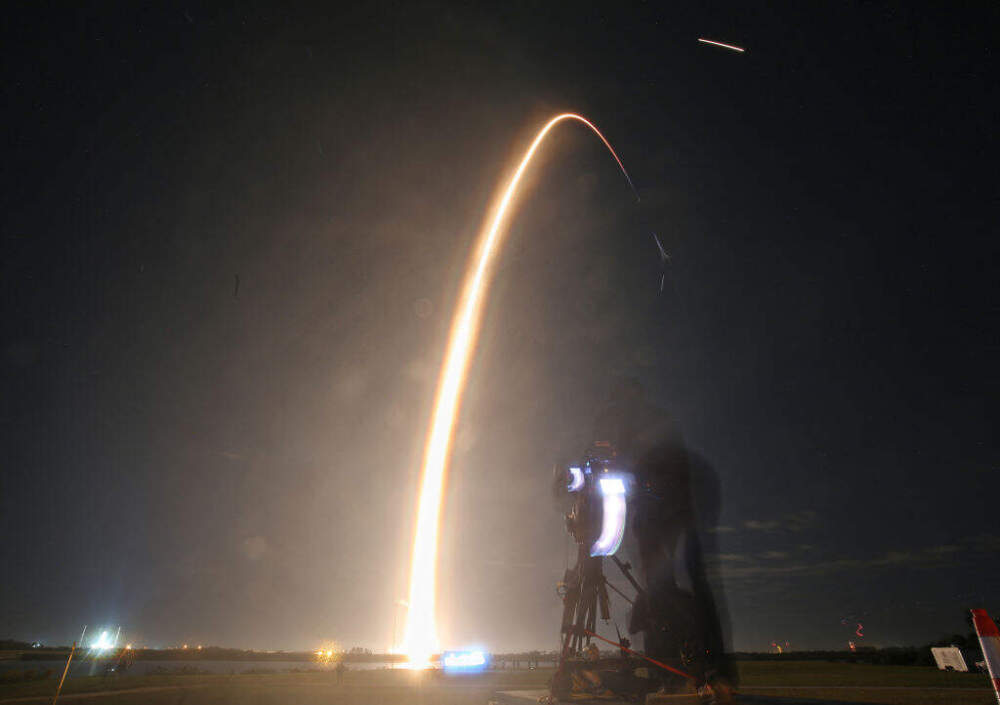Advertisement
Commentary
Why a private mission to the moon is still a win for America

In spaceflight lingo, “seven minutes of terror” describes the tense stretch of time when mission control loses communication with a spacecraft during the final descent to its celestial destination. Throughout these seemingly endless minutes, humans can only cross their fingers and hope the craft navigates the landing successfully on its own.
While seven minutes sounds like a long time to be out of contact with a spacecraft, the past two successful moon landings — India’s in 2023 and Japan’s earlier this year — involved 18 and 20 minutes of terrifying silence. Thursday, employees of Intuitive Machines, SpaceX and NASA will endure a similar, agonizing silence as the Odysseus lander tries to settle safely on the moon.
A successful lunar landing by Odysseus would be the first by a private company and would underscore the fundamental role public-private partnerships will play in America's space future. It would also be a much-needed win for American space flight, which for years has been in a holding pattern. Although the U.S. was the first country to put a person on the moon, we've long been behind in the race to return and to develop a consistent lunar presence.
Odysseus, made by Intuitive Machines and affectionately known as “Odie,” launched on Feb. 15. The six-day journey to lunar orbit will culminate in a landing attempt in a crater called Malapert A, near the south pole of the moon. So far, only spacecraft from China and India have landed on this hemisphere of the moon, with India’s Chandrayaan-3 touching down farther south in a region scientists believe contains large quantities of water in the form of ice. Extracting and processing that ice could support astronauts living on the moon, as well as facilitate the production of rocket fuel, sparing crews from having to return to Earth to refuel.
This mission is significant and historic. If successful, Odysseus would be the first spacecraft made by a private company to land on the moon. All of the other landers have been part of government missions. SpaceX takes both astronauts and supplies to the International Space Station, but neither that company nor any other has made it to another celestial body intact. Three private companies have tried in recent years: Israel’s Beresheet lander (2019) and Japan’s Hakuto-R (2023) both smashed into the lunar surface, and earlier this year, the Peregrine lander made by American company Astrobiotic suffered a propellant leak and eventually burned up in Earth’s atmosphere.
While collaborations between NASA and private companies aren’t new (in addition to transport services, NASA has long contracted private companies to make space shuttles and rockets), the partnerships involved in the Odysseus mission resemble nesting dolls — inside each piece of equipment is an object made by another entity, indicating how crucial these alliances have become. SpaceX’s Falcon 9 rocket booster launched from NASA’s Kennedy Space Center.
That rocket carried a lunar lander made by Intuitive Machines. Inside that lander are six NASA instruments that will harvest data about the nearby environment for use in future lunar missions. Odie is also carrying payloads from private customers, including Columbia Sportswear (what better way to test insulation?) and sculptor Jeff Koons, who created 150 small pieces for his Moon Phases Project, which may soon become the first art on the moon. Also among the interesting cargo is Arch Mission Foundation’s LunaPrise, part of its Lunar Lab Repository project intended to store human knowledge securely forever. (People can submit stories and information, or “Lunagrams,” online).

A successful landing would signify a much-needed win for American space ventures. The U.S. hasn’t landed anything or anyone on the moon in this millennium (the last Apollo mission was in 1972). Ironically, neither has Russia; in 2023, Russia's first lunar spacecraft in nearly 50 years crashed into the moon’s surface. China, India and Japan's successful robotic moon landings in the past five years represent a power shift likely to have implications for years, if not decades, to come.
Finally, this mission is an important step in returning humans to the moon. The last human to set foot on the lunar surface, Gene Cernan, did so in 1972. The Apollo program was more about winning the Space Race than establishing a consistent (or even sporadic) presence on the moon. NASA, the only organization to put a person on the moon, is incredibly out of practice. Successful robotic lunar landings are no easy feat, as evidenced by recent failures. NASA can make future landings easier by leveraging Odysseus to gather and transmit topographical and other environmental data back to Earth.
NASA’s Artemis program seeks to return humans — including the first female and the first person of color — to the moon. Artemis III, the first crewed mission, was originally scheduled for late 2025 but has been pushed back to late 2026. Many believe even that date to be optimistic and consider 2027 a more likely timeframe. Additional failures in lunar spacecraft landings, whether private or national, could highlight concerns or implications that could add more time to these scheduled missions.
Odysseus has sent back its first batch of space selfies from the journey. Soon, those selfies might include images from the moon. If that happens, Odysseus will explore the lunar surface for a week. When the lunar night — a frigid, two-week stretch of darkness — sets in, Odie’s mission will conclude. To learn whether Odie gets that far and what it learns on the moon, we’ll have to watch and wait.
